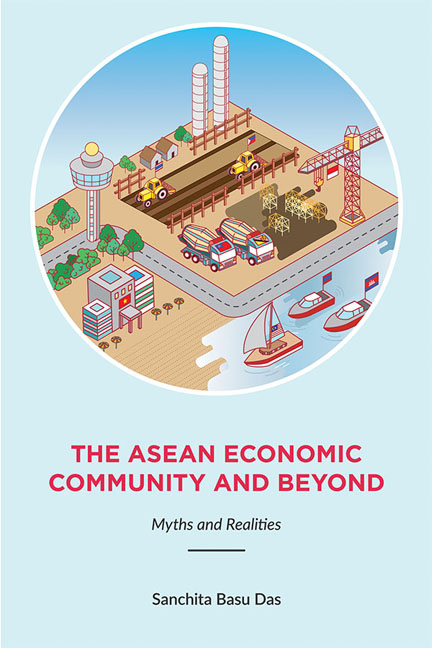Book contents
- Frontmatter
- Dedication
- Contents
- Foreword
- Acknowledgements
- Abbreviations
- 1 Introduction: The ASEAN Economic Community and Beyond
- I THE ASEAN ECONOMIC COMMUNITY (AEC)
- II BEYOND THE ASEAN ECONOMIC COMMUNITY
- III AN ASEAN PERSPECTIVE OF REGIONAL CONNECTIVITY
- 18 Promoting Asia's Infrastructure for Regional Trade and Investment
- 19 Addressing Infrastructure Financing in Asia
- 20 APEC and ASEAN Connectivity: Areas of Mutual Interest and Prospects of Cooperation
- 21 China's Three-pronged Strategy on Regional Connectivity
- 22 Can the China-led AIIB Support the ASEAN Connectivity Master Plan?
- Appendix: Summary of the Trans-pacific Partnership Agreement
- Index
- About the Author
20 - APEC and ASEAN Connectivity: Areas of Mutual Interest and Prospects of Cooperation
from III - AN ASEAN PERSPECTIVE OF REGIONAL CONNECTIVITY
Published online by Cambridge University Press: 19 May 2017
- Frontmatter
- Dedication
- Contents
- Foreword
- Acknowledgements
- Abbreviations
- 1 Introduction: The ASEAN Economic Community and Beyond
- I THE ASEAN ECONOMIC COMMUNITY (AEC)
- II BEYOND THE ASEAN ECONOMIC COMMUNITY
- III AN ASEAN PERSPECTIVE OF REGIONAL CONNECTIVITY
- 18 Promoting Asia's Infrastructure for Regional Trade and Investment
- 19 Addressing Infrastructure Financing in Asia
- 20 APEC and ASEAN Connectivity: Areas of Mutual Interest and Prospects of Cooperation
- 21 China's Three-pronged Strategy on Regional Connectivity
- 22 Can the China-led AIIB Support the ASEAN Connectivity Master Plan?
- Appendix: Summary of the Trans-pacific Partnership Agreement
- Index
- About the Author
Summary
ASEAN and APEC share many goals and priorities in promoting economic and developmental cooperation in Southeast Asia and the wider Pacific region. Connectivity is one of these. ASEAN endorsed the Master Plan on ASEAN Connectivity in 2010, while APEC, under Indonesia's Chairmanship in 2013, is looking at components similar to this plan. To avoid duplication and to optimize on limited resources, APEC has highlighted seven areas for possible collaboration with ASEAN — supply chain connectivity, trade facilitation, investment, disaster management, structural reform, food security and SMEs. But challenges persist. ASEAN wants to ensure its pivotal role in regional economic integration but feels threatened by the U.S. policy to promote APEC or TPP. Moreover, at this moment, ASEAN's participation in APEC is limited because three of its members — Myanmar, Cambodia, and Laos — are not part of APEC. With uncertainty in the West, cooperation in Asia is likely to gain importance. Cooperation amongst Asian neighbours can play the role of “bridge builder” between individual Asian economies with the rest of the world. This can reduce disparities in income and have positive spillover effects for technological development, energy security, disaster preparedness and other critical areas.
INTRODUCTION
For the past two decades, APEC and ASEAN have been working to promote regional economic integration in Asia. While APEC with its twenty-one member states is the much wider organization, ASEAN is constituted of ten members in close geographical proximity and boasts free trade agreements (FTAs) with China, India, the Republic of Korea, Japan, Australia and New Zealand. The latter also engages the United States and Russia during the East Asia Summit and brings in Canada and the European Union as dialogue partners. Besides economics, ASEAN also works on political-security and socio-cultural cooperation in the region.
Both APEC and ASEAN share similar goals and priorities on trade and investment liberalization, facilitation, economic and technical cooperation, food and energy security, disaster management, connectivity. However, these areas are tackled differently. For APEC, priorities are set from the top down, with direction from Economic Leaders. These are then combined with bottom-up ideas and initiatives with direct inputs from the business community, working groups and lessons from capacity building projects (Bollard 2013).
- Type
- Chapter
- Information
- The ASEAN Economic Community and BeyondMyths and Realities, pp. 218 - 234Publisher: ISEAS–Yusof Ishak InstitutePrint publication year: 2015



